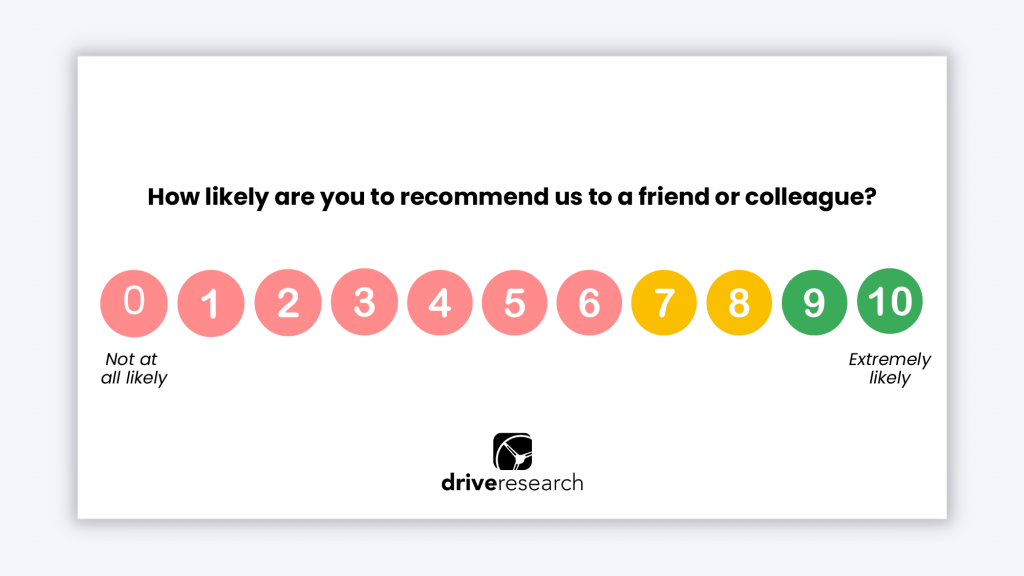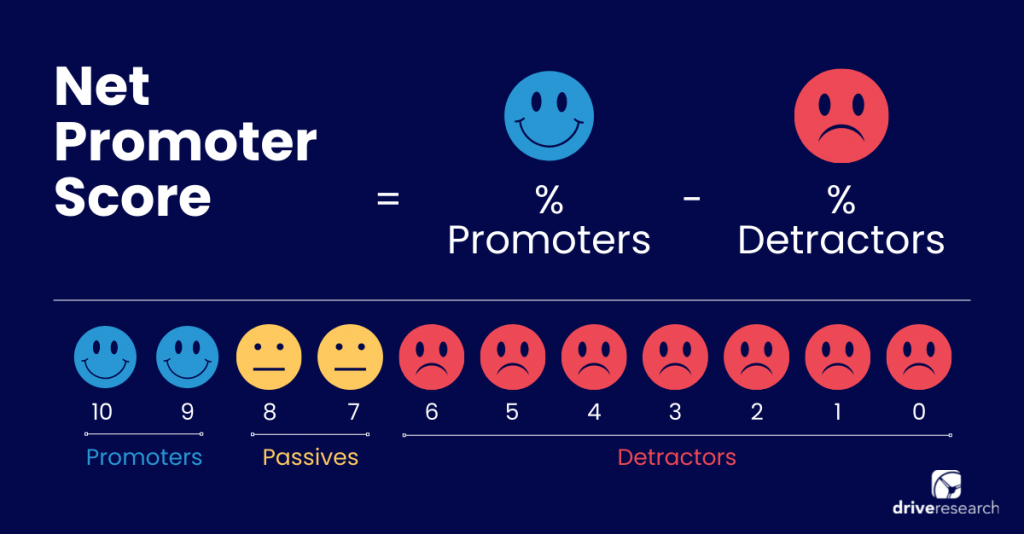
In the dynamic landscape of healthcare, where patient satisfaction and loyalty are paramount, the traditional metrics of success are changing.
Beyond clinical outcomes and operational efficiency, healthcare providers are increasingly recognizing the critical importance of patient experience.
That’s where Healthcare Net Promoter Score (NPS) comes in. By asking one simple question: “How likely are you to recommend us?” NPS captures key measurements of patient loyalty and the true value of care being delivered.
In this blog post, our healthcare market research company dives into the significance of healthcare NPS, drivers of patient loyalty, and implementing actionable strategies for improving scores.
What is a Healthcare Net Promoter Score?
Healthcare NPS, adapted from the business world’s net promoter score, offers a simple yet powerful way to gauge patient loyalty and likelihood to recommend healthcare services to others.
By asking patients a single question – “How likely are you to recommend our healthcare services to friends or family?” – providers can gain valuable insights into the overall patient experience.
While the calculation itself is simple, the insights from a healthcare NPS survey can be powerful. Patient feedback often highlights the key areas that most impact their experience
Healthcare improvement areas discovered through an NPS survey may include:
- Prioritizing patient communication
- Reducing wait times
- Lessening paperwork
- Supporting patients financially
Here are some other questions that can be used in a healthcare NPS survey:
- What is the main reason for the score you gave today?
- Can you share one thing we could have done to improve your experience?
- How would you describe your experience with our staff and providers?
- What would encourage you to continue choosing us for your care in the future?
- What one change would make the biggest difference in your overall satisfaction?
Generally, calculating the NPS of your company can help increase your patient satisfaction and build brand loyalty.
In a similar vein, measuring your healthcare NPS can help you retain patients to maintain a thriving practice.
For a quick overview of what net promoter score is, watch the video below.
How to Measure NPS for Healthcare Facilities
In the healthcare industry, optimizing patient experience is an ever-present challenge.
With roughly 60% of Americans stating they’ve had a negative medical experience, it’s critical facilities take initiative with improving patient experience.
Therefore, net promoter scores have become a popular metric in the past decade. This is largely due to their ability to reveal valuable insights for organizations.
To calculate the NPS for your healthcare business, you will need to send out a patient satisfaction survey to your list of current and past patients.
Questions in this survey will mainly follow the Likert scale. Following the “1 to 10” pattern, a Likert scale measures patient attitudes.
An example NPS example question is: On a scale from 0 to 10, how likely are you to recommend [healthcare facility] to others?

Then, scaled answers are used to calculate your healthcare net promoter score.
A customer satisfaction survey company, like Drive Research, will go through a rigorous online survey testing process to ensure everything runs smoothly.
Calculating Your Healthcare NPS
Three categories of patients will emerge based on responses from the patient satisfaction survey. These include:
- Promoters
- Passives
- Detractors
Once you understand how these groups affect your business, you can use their feedback to boost your customer retention strategy.
Below, we’ll go over what each term represents.
Promoters
A promoter selected 9 to 10 on the survey, meaning they would go out of their way to recommend your healthcare practice to others.
Promoters are the most loyal customers.
Passives
A passive customer rated 7 to 8 on the scale, meaning they feel satisfied with their care. That said, they will not often recommend it to others.
Passive customers are decently loyal to the brand but could be swayed by rivals and use other services.
Detractors
A detractor chose from 0 to 6 when considering when to recommend.
The range to be included as a detractor is larger than the first two categories.
This is because those who rate their satisfaction on lower tiers are more likely to resonate with negative aspects of the business.
Healthcare NPS Formula + Benchmark
The difference between the percentage of promoters and the percentage of detractors calculates the NPS.
Healthcare NPS = % of promoters – % of detractors
The total score can range from -100 to +100, with positive numbers being the “best.”
Though, according to Customer Gauge and their latest NPS benchmark report, +58 is the average net promoter score for the healthcare industry.

What Is a Good NPS Score for a Healthcare Company?
In general, a positive NPS is considered good, and a score above 0 is considered acceptable.
However, benchmarks for NPS scores can vary by industry. For healthcare companies, the average NPS may be influenced by factors such as the quality of medical care, patient experience, and overall customer service.
A good NPS for a healthcare company would typically fall within the positive range, with scores above 30 or 40 considered strong.
Keep in mind that what constitutes a “good” score can also depend on regional and industry norms, as well as the specific expectations and preferences of the patient population.
That’s why it’s so important to work with a net promoter score company. These organizations have access to industry, competitor, and local benchmarks to help understand where your healthcare NPS stacks up against others.
Also, by continuously measuring your healthcare net promoter score, you can see evolving trends in patient data. This is incredibly useful in improving the patient experience and ensuring good NPS scores down the line.
Running a Healthcare NPS Survey
Launching a healthcare Net Promoter Score (NPS) survey doesn’t need to be but it does require the right setup. The goal is to capture honest patient feedback that highlights satisfaction, loyalty, and areas for improvement.
The first step is choosing the right survey setup. There are NPS tools that help design, distribute, and analyze simple surveys. Using a third party NPS survey for more detailed data or complex projects can be better.
From there, decide how you’ll reach patients. Common channels include email, SMS, phone, website pop-ups, or in-app surveys. Email works well for longer surveys, while SMS or in-app surveys often get faster responses.
When creating your survey, keep it short and engaging. Start with the standard NPS question (“How likely are you to recommend our healthcare services to a friend or family member?”), then add 1–2 open-ended follow-ups that help uncover the “why” behind the score. A clear title, a short description, and a thank-you note also go a long way in boosting response rates.
Finally, don’t forget about sample size and follow-ups. Sending reminders to patients who haven’t responded and ensuring you have enough data points will make your results far more reliable.
Improving Your Healthcare Net Promoter Score
Many factors go into creating a “good” net promoter score in healthcare.
Ideally, the score should be updated annually and each year to be benchmarked against prior performance.
Calculating your healthcare organization’s NPS is a metric that can support long-term business development.
But how do you actually improve your score? Below are strategies our healthcare market research company recommends based on our experience measuring patient satisfaction with surveys.
1. Identify common themes among detractors
Before we jump in, we want to set the stage. Below are a few statistics about the current sentiment of patients.
- Future patients can form an opinion about a medical facility from one to six online reviews, meaning one poor review can do a lot of damage
- One in five patients has a hard time getting in touch with their medical office
- Up to 43% of millennial patients are on the verge of changing practices
- 88% of patients take notice of a burned-out doctor
Each of these issues set the stage for what could cause someone to become a “passive” or “detractor.”
Detractors are often honest about issues that exist within your healthcare facility, and those criticisms should be taken seriously.
Input from this audience can highlight what negative factors are most impacting the patient experience.
Here you can determine what areas are high priority, what can be delayed, and what can be ignored.
These changes can make the biggest difference in improving customer satisfaction and your business as a whole.
2. Spotlight promoter opinions
While it’s always important to understand negative feedback, positive opinions from promoters are also valuable in bettering your service.
Promoters with positive sentiment for the brand can share the most impactful elements of their healthcare experience in NPS surveys.
Once you find the key differentiating factors that promoters share, they should be prioritized throughout the business.
Ensuring all patients enjoy the benefits of your healthcare facility could push passives to become promoters.
For example, promoters said the customer service at your healthcare organization increased their loyalty.
The customer service team should be aware of the positive feedback, and ensure it continues.
If a passive has a great customer service experience, they may become a promoter and recommend your organization to others.
This process ensures that healthcare professionals are listening to customers and understand what they are looking for in their healthcare provider.
3. Ask passives how to improve
Healthcare organizations should pay close attention to feedback from passives, as they are more likely to switch to promoters.
Targeting passives directly can push your organization to resolve the issues that prevent them from recommending the brand.
In many cases, making a specifically targeted change based on passives can make an impact on future healthcare net promoter scores.
This can include feedback on marketing materials, such as what channels and positioning to use.
It could inform the healthcare organization’s strategy and shift it to be more engaging to customers.
Value of Calculating NPS in Healthcare
Net promoter scores are a widely used market research tool for healthcare organizations because they can bring valuable change to the organization in a short time.
In fact, nearly two-thirds of healthcare organizations are prioritizing improving the patient experience. Luckily, NPS is a metric that can directly support organizational experience.

Below are more significant benefits of measuring healthcare NPS.
1. Improving patient loyalty
Patient loyalty is a great marker of a successful healthcare organization.
Your healthcare net promoter score is a simple way to measure patient loyalty, especially since it’s always changing.
The metric offers a true picture of the likelihood of a recommendation, and patients’ feelings about a brand.
Honest feedback from patients can show organizations what factors have made promoters loyal and kept detractors away.
Therefore, patient loyalty should be built into the business model of healthcare facilities, and this can be done effectively by analyzing NPS results.
Higher satisfaction rates build loyalty, and loyal customers are more likely to recommend your services to others and grow your clientele.
Aside from measuring NPS, consider implementing patient loyalty surveys for an even deeper look.
Recommended Reading: How to Conduct a Patient Loyalty Survey
2. Reduce patient churn
Patient turnover can be reduced when your organization learns about customer pain points. Thankfully, healthcare market research focuses on permanently ending those areas of frustration and dissatisfaction.
For example, if a common response in the healthcare NPS survey was that your organization has excessive wait times, this issue can be focused on to improve first.
Similarly, you can capitalize on what promoters said was positive about their healthcare experiences. This can be continued and replicated with other patients. Or, featured in marketing materials to encourage new business.
3. Earn benchmarking data
Healthcare net promoter scores are often used as internal metrics for future comparison.
Analyzing trends in patient loyalty over time highlights ways to improve your healthcare organization.
For this to be truly effective, you should benchmark your score, or add context to it. This adds detail to the patient satisfaction metric.
This could mean comparing how your score changes over time or how they currently compare to industry standards and competitors.
Additionally, to compare with a competing healthcare facility, you can ask survey respondents how likely they are to recommend the competitor or about their strengths and weaknesses.
Contact Our Healthcare Market Research Company
There are many factors that go into creating a positive patient experience. By measuring the NPS of your medical facility, you’ll be able to understand the unique needs of your patients.
Drive Research is a national full-service market research firm. Our team will partner with yours to calculate an accurate NPS for your healthcare organization.
Contact us today for more information.



